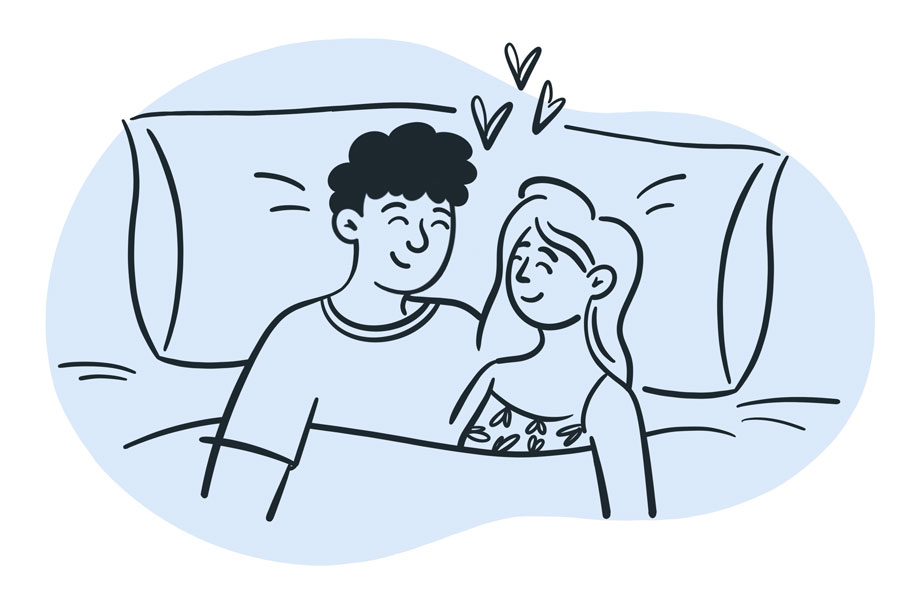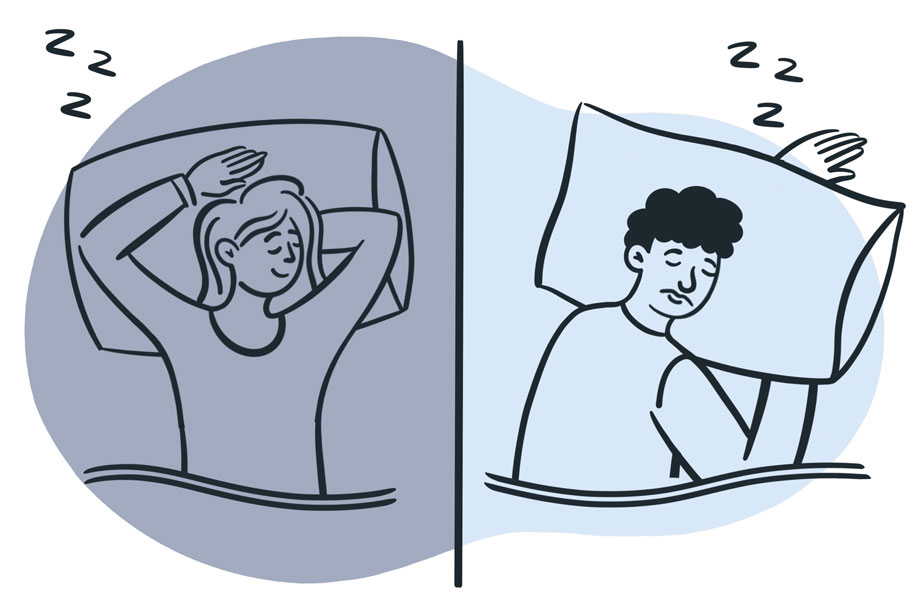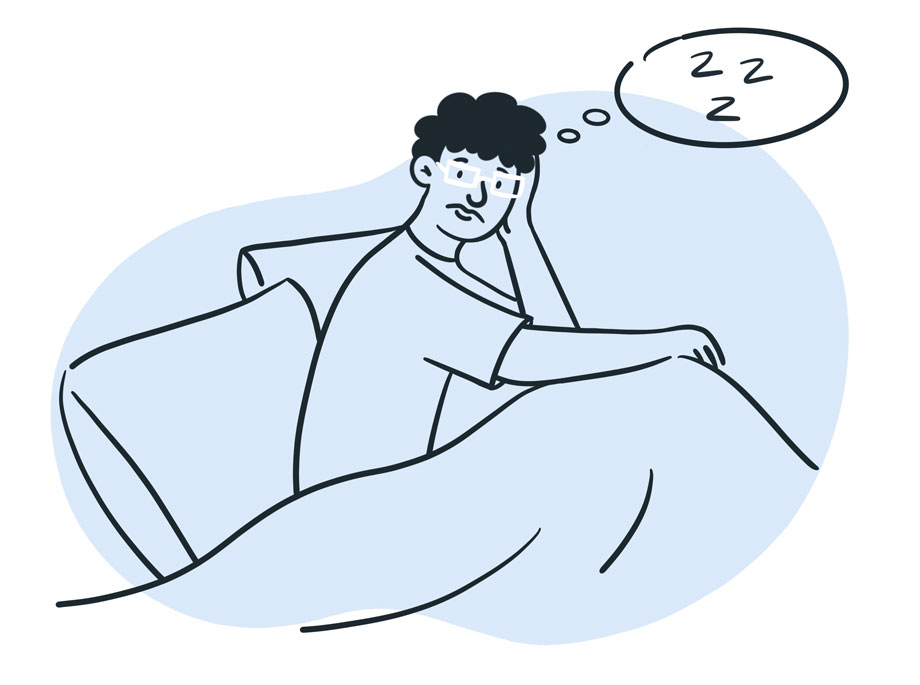Sleep Divorce
Disclosure: By clicking on the product links in this article, Mattress Nerd may receive a commission fee at no cost to you, the reader. Read full disclosure statement.
Sleep Divorce
You love your partner. But let’s be honest. You don’t always love sleeping with them. He snores. She hogs the blankets. You both toss and turn throughout the night and wake feeling like you’ve barely slept a wink. Mounting sleep debt can have detrimental effects on your physical and mental health, and take a toll on your quality of life. You may be wondering how you can get a good night’s sleep without ending your relationship. Before you pack up and move out, you may want to consider a sleep divorce.
The word “divorce” can have negative connotations signifying the end of a relationship. A sleep divorce isn’t nearly as harsh and, in fact, may save your relationship and even improve it.
What is a Sleep Divorce?
A sleep divorce is an arrangement between two people who live together as a couple — married or otherwise — who choose to sleep separately from each other. That can mean in separate beds, in separate rooms, or even at separate times of the day and night. And it’s not that uncommon.
According to a study by bed manufacturer Sealy, more than one-third of all couples who live together regularly sleep in separate beds. That’s in step with a National Sleep Foundation survey which found that an estimated one in four American couples sleep apart.
Sleep divorces are gaining traction with younger generations. According to the National Sleep Foundation study, couples ages 24 to 35 were the most likely to sleep apart. Married couples were more likely to sleep together, however nearly 25% of them still opted to sleep in separate bedrooms.
Many of the people choosing solitary sleep over co-sleeping are quite well known, including former presidents John Kennedy and Donald Trump, both of whom had separate bedrooms from their spouses within the White House. And there are plenty of other famous couples who claim sleeping apart has enriched their unions. Among them are former professional footballer David Beckham and his wife Victoria, American actress Gwyneth Paltrow and her TV writer-producer husband Brad Falchuk, Sex and the City star Sarah Jessica Parker and actor Matthew Broderick, and Queen Elizabeth II and Prince Philip.
Sleeping Together vs Sleeping in Separate Beds
A sleep divorce isn’t necessarily the right solution for every couple. Before you choose a slumber separation, consider the pros and cons of each.

Sleeping Together
Benefits of Sleeping Together
- Sleeping together is an intimate experience and, like cuddling, can trigger the release of oxytocin, also known as the love hormone. It helps build and strengthen the bond between couples. In fact, the hormone also plays a role in bonding a mother to her newborn child.
- Couples who sleep together have more restorative rapid-eye movement (REM) sleep and less disruptions during REM, according to a recent study published in the journal Frontiers in Psychiatry. REM sleep is believed to aid in memory, learning, and emotional processing and may be important for sustaining emotionally healthy and loving relationships.
- Sleeping with a romantic partner can also reduce sleep apnea risk, lessen insomnia severity, and improve overall sleep quality, according to a study from the University of Arizona. Co-sleeping couples also fall asleep faster, stay asleep longer, and feel less fatigued the day after than those who prefer to sleep apart.
- The same team of researchers also found that sleeping with a partner was associated with lower depression, anxiety, and stress scores.
Drawbacks to Sleeping Together
- Sleeping together may reduce a person’s risk of sleep disorders, but many bed partners still suffer from snoring, sleep apnea, restless leg syndrome, and other sleep problems. There’s no doubt these issues can disrupt their bed mates’ sleep. Not that proof is needed to make such claims, but one European study found women who slept with snorers experienced poorer sleep quality and more fragmented sleep than those who slept with non-snorers.
- Sleeping with a disruptive partner can wreak havoc on your relationship, too. A recent study revealed that 1 in 10 adults said their co-sleeping struggles are so bad they’ve actually considered divorcing or leaving their partner altogether.
- Some people rely on electronic devices to put them to sleep. Noisy TVs and glowing smartphone screens can be distracting to their bed partner desperately trying to get some shut-eye. While this may be grounds for a sleep divorce, it can be averted by ear plugs, sound machines, or sleep masks.
- Sleep deprivation, over time, can leave you moody, irritable, and generally unpleasant to be around. If that’s not enough to drive away a partner, sleep deprivation can also zap sex drives and lead to erectile dysfunction.

Sleeping Apart
Benefits of a Sleep Divorce
- A recent study found that nearly 60% of couples who sleep separately said having separate sleep arrangements not only improved the quality of their sleep but also enhanced their relationship in general. Perhaps this is because getting sufficient sleep improves mood as well as sex drive.
- A survey by U.K. bed retailer Benson for Beds on the sleeping habits of 2,000 couples found that couples who sleep apart claim to have better quality sex as well as more of it. 38% of couples who sleep in separate beds said that a sleep divorce has improved their overall relationship.
Drawbacks of a Sleep Divorce
- Sleeping in separate beds can cut into your intimacy by leaving less time for impromptu sexual romps or late-night pillow talks. In the long-term, this can spell disaster to your relationship if efforts aren’t made by both partners to maintain intimacy. “Sleeping apart can interfere with intimacy, sexual and emotional. Couples may find themselves having sex less often when they’re regularly sleeping apart,” says Michael J. Breus, PhD, a clinical psychologist with the American Board of Sleep. “Partners also may miss the physical closeness of sleeping together, and the emotional bond that it confers for many people.”
- Divorce can be expensive, even sleep divorces. You will need to dedicate another room in your house for your partner and may need to relocate to another house to accommodate the move. Even if you have the space in your current home, you may still need to buy a new bed. When you add in the cost of a new mattress, bed frame, sheets, blankets, pillows, and so on, the expense can add up.
How Do I Know If It’s Time for a Sleep Divorce?
Both partners can benefit from a sleep divorce in certain circumstances. For example:
- You and your partner have different schedules where you go to bed or wake up at different times.
- One of you snores or has a sleep disorder — whether diagnosed or suspected.
- You disagree about how hot or cold the thermostat should be at night.
- Your partner prefers to fall asleep with the TV on while you prefer darkness and silence.
Some signs that may suggest it’s time to consider separate sleeping quarters include:
- You become anxious the closer you get to bedtime.
- You rely on sleeping pills or other sleep aids to fall asleep.
- You enjoy one too many nightcaps at night, relying on alcohol to help you fall asleep.
Considerations of sleeping with a partner
Not everyone wants a sleep divorce. The good news is that many issues that result in a sleep divorce may be eliminated through compromise. For example, if your partner’s snoring is keeping you up all night, encourage them to try products such as nasal strips or an anti-snoring device. If your bed mate suggests you may have a sleeping disorder, get it checked out by your doctor or sleep specialist and have the condition treated.
You may also want to consider a new mattress. Queen-sized beds are great for cuddling, but king-sized ones allow for closeness while also providing plenty of room for spreading out. If your bed mate tends to toss and turn, look for a mattress with motion isolation features which greatly minimizes the disturbance to sleepers.
How to Take First Steps in Getting a Sleep Divorce
A sleep divorce isn’t something to jump into blindly. You’ll want to be thoughtful about how you present the idea to avert any hurt feelings. And you should develop a plan if you decide to move forward. Here are some steps to take as you embark on a sleep divorce journey:
Communicate: Schedule time to talk with your partner about the possibility of sleeping separately. Choose a time when both of you are not rushed or stressed. Keep your tone positive and avoid placing blame. The focus should be on the quality of your relationship and how it can be improved when you both can have a good night’s sleep.
Discuss Logistics: Sleep divorces can mean sleeping in separate beds in the same room or separate rooms in the same house. For some, it can mean sleeping in separate residences in close proximity to each other. Discuss which would work best for both of you.
Do a Test Run: Before one of you moves out of the shared bedroom, test the proposed sleeping arrangement for a few days or even weeks to be sure it’s providing the sleep benefits it was intended. After your test period, you’ll also want to assess your relationship to ensure it’s not being compromised in the process.
Make Adjustments, if Necessary: You and your partner may decide that your sleeping arrangement needs a bit of tweaking. For example, if one of you feels the separate bed situation is curbing intimacy, discuss cuddling together before you separate for sleep at night or after waking up in the morning.
Be Appreciative: A sleep divorce may take some adjusting to at first, especially if one partner is hesitant to do so. Being appreciative of their willingness to give it a try is an important step in making your sleep divorce a success.

FAQs
How many married couples sleep in separate rooms?
An estimated 25% of couples sleep in separate beds, according to a study by the National Sleep Foundation.
Can sleeping in different beds lead to a divorce?
Couples who are used to sleeping together may become emotionally and/or sexually disconnected from their partner after switching to separate beds. This can be averted if both parties make an effort to maintain a level of intimacy following a sleep divorce.
How do I get a sleep divorce?
Asking your partner for a sleep divorce may cause hurt feelings at first. It’s important to present the idea in a positive light without placing blame. It’s also wise to test out the idea for a few days or weeks before committing to separate beds.
How to tell my partner I want a sleep divorce?
Take time to talk with your partner about why you want a sleep divorce and how it could benefit both of you — and even improve your relationship.
Final Thoughts
Sleep divorces are becoming more popular these days, and for good reason. A good night’s sleep not only improves your mood and your health, it can also enhance your relationship. But it isn’t a decision to take lightly. Consider the pros and cons of sleeping separately and make time to discuss the idea with your partner. You may also want to discuss whether the issues that have you seeking a sleep divorce in the first place can be handled through compromise or treatment. In the end, you may decide it’s not right for you after all.